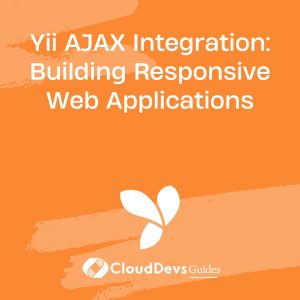A Comprehensive Guide to Yii: The Ultimate PHP Framework
In the world of web development, PHP has been a dominant language for building dynamic and interactive websites. To streamline the development process and enhance productivity, several PHP frameworks have emerged. Among them, Yii stands out as a robust and efficient framework that offers a wide range of features for building modern web applications. In this comprehensive guide, we will delve into the world of Yii, exploring its key features, benefits, and providing code samples to illustrate its power and versatility.
1. What is Yii?
Yii (pronounced “Yee”) is an open-source PHP framework that provides a solid foundation for developing web applications. It follows the Model-View-Controller (MVC) architectural pattern, which separates application logic from presentation, making it easier to maintain and extend the codebase.
2. Why Choose Yii?
Yii offers several advantages that make it a popular choice among PHP developers:
- High Performance: Yii is designed to be highly performant, optimized for handling large-scale applications and heavy workloads.
- Code Generation: Yii includes a powerful code generator called Gii, which can automatically generate models, controllers, and views, saving developers a significant amount of time.
- Database Support: Yii supports various database systems, including MySQL, PostgreSQL, SQLite, and Oracle, providing flexible options for data storage.
- Extensibility: Yii follows a modular approach, allowing developers to easily extend and customize its components based on their specific project requirements.
- Security: Yii incorporates various security measures, such as input validation, output filtering, and protection against cross-site scripting (XSS) and cross-site request forgery (CSRF) attacks.
- Rich Widget Library: Yii comes with a comprehensive set of pre-built widgets, simplifying the creation of interactive and user-friendly interfaces.
- Active Community: Yii has a vibrant community of developers who actively contribute to its development and provide support through forums, documentation, and extensions.
3. Key Features of Yii
3.1 Model-View-Controller (MVC) Architecture
Yii follows the MVC architectural pattern, which promotes separation of concerns and modular development. The model represents the data and business logic, the view handles the presentation layer, and the controller acts as the mediator between the model and view, processing user requests and updating the model accordingly.
3.2 Gii Code Generator
Gii is Yii’s code generator, which helps developers rapidly create code scaffolding. It can automatically generate model classes, CRUD operations, forms, and other boilerplate code based on database tables or predefined templates. This feature significantly reduces development time and increases productivity.
3.3 Database Access Objects (DAO)
Yii provides a powerful database abstraction layer called Database Access Objects (DAO) that simplifies database interactions. Developers can write database queries in a consistent and safe manner, without having to worry about SQL injection vulnerabilities.
3.4 Form Validation and Widget Library
Yii includes a robust form validation mechanism that simplifies the process of validating user input. It offers a wide range of validation rules and supports client-side validation, reducing the need for server round-trips. Additionally, Yii provides a rich widget library with pre-built UI components like grids, dropdowns, and date pickers, making it easier to create interactive forms and user interfaces.
3.5 Caching and Performance Optimization
Yii offers various caching mechanisms to improve application performance. It supports data caching, fragment caching, and page caching, allowing developers to store frequently accessed data in cache to reduce database queries and enhance response times.
3.6 Security Measures
Yii incorporates numerous security measures to protect web applications from common vulnerabilities. It provides input validation and output filtering to prevent attacks like XSS and CSRF. Additionally, Yii supports authentication and authorization mechanisms, role-based access control, and encryption for sensitive data.
4. Getting Started with Yii
4.1 Installation
To get started with Yii, you need to have PHP installed on your machine. Yii is compatible with PHP 5.4 and higher versions. You can install Yii using Composer, a popular package manager for PHP. Run the following command in your terminal to install Yii:
lua composer create-project --prefer-dist yiisoft/yii2-app-basic myapp
4.2 Creating Your First Yii Application
After installing Yii, you can create a new Yii application by executing the following command:
php yii serve
This command starts the built-in web server and serves your application. You can access it in your browser at http://localhost:8080.
5. Yii in Action: Code Samples
5.1 Creating Models, Views, and Controllers
Yii makes it easy to create models, views, and controllers. Here’s an example of creating a model named User:
javascript
class User extends \yii\db\ActiveRecord
{
// ...
}
To create a controller, extend the yii\web\Controller class and define action methods:
kotlin
class SiteController extends \yii\web\Controller
{
public function actionIndex()
{
return $this->render('index');
}
}
For creating views, you can use PHP templates or Yii’s powerful templating engine:
php
<?php
use yii\helpers\Html;
/* @var $this yii\web\View */
/* @var $model app\models\User */
$this->title = 'Create User';
$this->params['breadcrumbs'][] = ['label' => 'Users', 'url' => ['index']];
$this->params['breadcrumbs'][] = $this->title;
?>
<h1><?= Html::encode($this->title) ?></h1>
<?= $this->render('_form', [
'model' => $model,
]) ?>
5.2 Handling Database Operations
Yii provides a convenient ActiveRecord pattern for database operations. Here’s an example of querying a database table using Yii’s ActiveRecord:
php
$users = User::find()->where(['status' => 1])->orderBy('username')->all();
To insert a new record:
php $user = new User(); $user->username = 'john_doe'; $user->email = 'john@example.com'; $user->save();
5.3 Form Validation and Rendering Widgets
Yii’s form validation simplifies the process of validating user input. Here’s an example of a login form with validation rules:
php
class LoginForm extends \yii\base\Model
{
public $username;
public $password;
public function rules()
{
return [
[['username', 'password'], 'required'],
['password', 'validatePassword'],
['captcha', 'captchaAction' => 'site/captcha'],
];
}
public function validatePassword($attribute, $params)
{
// Check if the password is valid
}
}
In the view, you can render the form using Yii’s widget:
php
<?php $form = ActiveForm::begin(); ?>
<?= $form->field($model, 'username')->textInput() ?>
<?= $form->field($model, 'password')->passwordInput() ?>
<div class="form-group">
<?= Html::submitButton('Login', ['class' => 'btn btn-primary']) ?>
</div>
<?php ActiveForm::end(); ?>
5.4 Caching and Performance Optimization
Yii provides various caching techniques to improve application performance. Here’s an example of caching a database query result:
php
$users = Yii::$app->cache->get('users');
if ($users === false) {
$users = User::find()->all();
Yii::$app->cache->set('users', $users, 3600);
}
// Use the cached data
5.5 Implementing Security Measures
Yii incorporates security measures to protect against common vulnerabilities. Here’s an example of input validation:
php
use yii\helpers\Html;
use yii\web\ForbiddenHttpException;
function savePost($post)
{
if (Html::encode($post->title) !== $post->title) {
throw new ForbiddenHttpException('Invalid characters in the post title.');
}
// Save the post
}
You can also implement authentication and authorization using Yii’s built-in mechanisms.
Conclusion
In this comprehensive guide, we explored Yii, a powerful PHP framework for building modern web applications. We discussed its key features, such as the MVC architecture, Gii code generator, database access objects, form validation, caching, and security measures. We also provided code samples to illustrate Yii’s capabilities. With its robust features and active community support, Yii offers a solid foundation for developing efficient and secure web applications. Whether you’re a beginner or an experienced PHP developer, Yii is definitely worth considering for your next project.
Table of Contents









